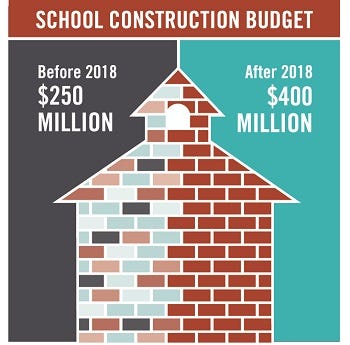What About My School’s Leaky Roof?
Who decides where the money goes?

You probably read about students freezing in Baltimore City schools when more than one-third of the city’s schools — and students — went without sufficient heat during the cold spell last January. It was a big story that gained national attention. Nine months later, it was the heat wave at the start of the school year with 105 degree heat in- dices and schools struggling with inadequate, or no, air conditioning. Baltimore City schools aren’t the only woefully inadequate buildings in Maryland, even if they did get most of the press this past year. Mold, safety issues, overcrowding, heating and air conditioning problems, and more plague some schools in every county.
Who Decides Where School Construction Investments Are Made?
It’s the Interagency Commission on School Construction (IAC) — a little-known, but very important, agency that votes yea or nay on school construction requests. Passage of the 21st Century School Facilities Act during the 2018 legislative session gave the IAC responsibilities formerly the purview of the three-member Board of Public Works.
The newly revamped, nine-member IAC now has the authority to adopt regulations and grant final approval on school construction projects. Importantly, the bill also streamlines some regulatory processes related to school construction and adds new financial commitments to address the tremendous backlog of construction projects across the state. It also establishes and funds the School Safety Grant Program at $10 million per year, helping school districts make school security improvements like lockable classroom doors.
WASHINGTON — Lawmakers in Annapolis, Maryland, passed a bill that will change the way local school construction funding…wtop.com
The IAC works as an independent body of the Maryland State Department of Education and is made up of nine members — the state superintendent of schools, the state’s planning and general services secretaries, four members appointed by the governor, one by the Senate president, and one by the speaker of the House.
But Where Does the Money Come from?
According to the two-year study by the 21st Century School Facilities Commission, Maryland school construction needs add up to $4 billion. The legislation passed in April upped the annual budget minimum for school construction from $250 million to $400 million — a 60% jump. But don’t confuse that $4 billion construction need with the $3 billion annual shortfall in school funding.

That $3 billion annual budget gap is for ongoing operating expenses — think salaries and funding for specific programs like pre-kindergarten. The $4 billion school construction backlog is made up of a series of one-time expenses required to upgrade school facilities across the state — installing a new HVAC system here, building a new elementary school there. These are two different budgets and two different pots of money — school construction is funded largely by government bond issues; the operating budget is funded largely by taxes.
When the 2019 General Assembly revamps and improves the state’s school funding formula for the first time in 20 years, their focus will be on the $3 billion operating expenses shortfall. Look for a lot of focus on improving educator salaries, expanding programs such as pre-k and career technical education, and adding school staff. For school construction issues, keep an eye on the IAC and its expanded ability to address backlogs thanks to the new, higher funding floor of $400 million annually.

